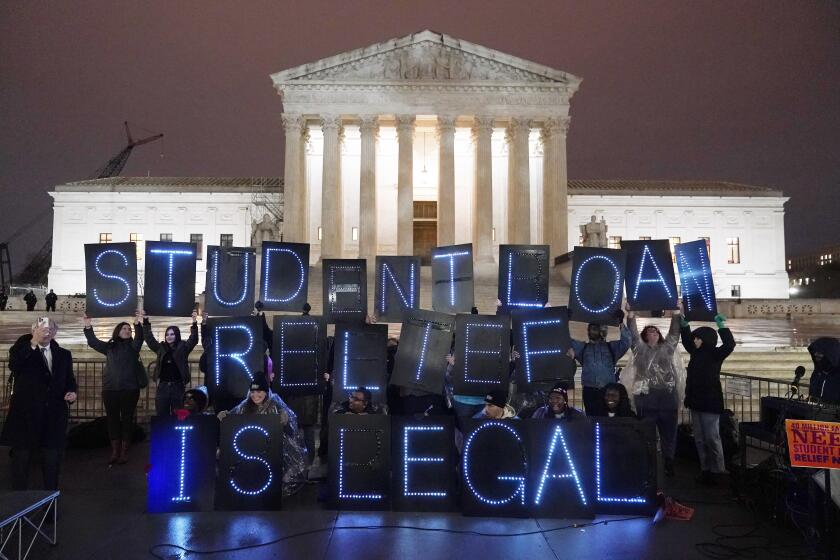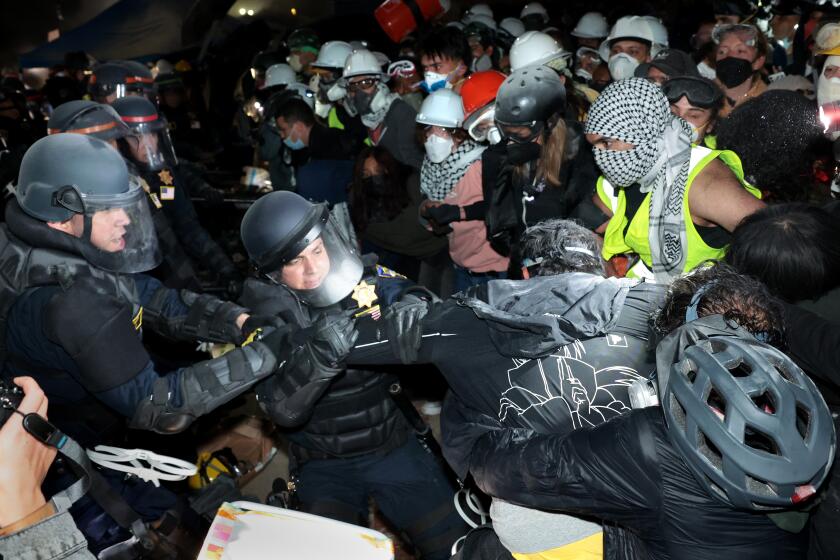Less Commute, More Compute at CSUN in Cyberspace : <i> “What is the use of a book,” thought Alice, “without pictures or conversation?” </i> --Lewis Carroll
Computer Guy Ron Heeb had heard by electronic mail that I was going to call. His Mac later reminded him of our appointment, probably by beeping a couple of bars of “Scotland the Brave.”
We could have met on the Internet but just to be contrary, I insisted we conduct the interview the old-fashioned way: in person. After all, to witness, to Be There, is the most satisfying part of a reporter’s job.
Chalk up another one to progress.
It took only a few minutes for Heeb--or “rheebcsun.edu” as he is known on the Net--to demonstrate how Being There has a much different meaning in the computer age.
Heeb, 34, is the architect of a campus computer service making its debut this semester at Cal State Northridge--the first step toward what may someday be a completely computerized school, where students could attend class, flirt with the opposite sex, take finals and order pizza, all from their home PCs.
Heeb is of the generation that discovered computers early enough in life to have missed their novelty. Instead, he can describe his machine as “more friendly” than its Big Blue equivalent, even though it appears no more friendly than say, my television (which on reflection is probably more temperamental than my fridge).
Heeb earned his computer science degree at CSUN and has worked full time there ever since. He occupies a cubicle in one of dozens of portable buildings scattered throughout the Northridge campus to replace buildings devastated by the Jan. 17 earthquake.
If you were once familiar with the campus, almost nothing is where it used to be. Even now, many students appear to wander the grounds in a daze, looking like peasants at a carnival shell game.
School administrators say it will take years and a fortune in repair money to piece the campus back together. A tour of Heeb’s school of the future may have you asking, “Why bother?”
Sometime soon, students who can scrape together $1,500 or so for a decent computer--about the cost of the usual commuter jalopy--will almost never have to actually visit the school.
CSUN may trade its reputation as a commuter campus for that of a computer campus, where students will evaporate into long strings of 1s and 0s, ghosts in an algorithm.
Heeb showed me around school, not the broken, boarded-up and scaffold-wrapped version in the cruelly real world, but the unscathed school that stands tall and proud on his 16-inch color monitor. There stands a pristine administration building; the busted science complex is reborn, with all its test tubes unbroken and back in little wooden racks; the stately columns of the Oviatt Library are on their feet and again holding up the roof.
When his digital school is finished, students with home computers will be able to use these glamorous images as guides to information that today they must visit those buildings to get, such as class schedules or assignments or discussions with a prof.
Heeb’s official job--underwritten by an initial $10,000 grant from the chancellor’s office--is to develop a system of electronic kiosks, computer stations to be set up around the campus someday that will allow students and everyone else to find their way around school with fancy maps, as well as check on class schedules, campus activities and social events. It’s called Project Looking-Glass, after author and mathematician Lewis Carroll’s book “Through the Looking-Glass and What Alice Found There.”
Alice in Cybernetic Wonderland, in other words.
Even computer illiterates can join in, simply by pushing buttons marked “Parking,” “Food” or “Restrooms.”
Among the bells and whistles being planned are messages from CSUN President Blenda J. Wilson, whose computer-generated image and voice will greet students and visitors, lending a Disneyesque guidance to the lost, the hungry and the incontinent.
While the actual kiosks--think of a shopping mall’s You Are Here display--are probably years away, a lot of the information is already available by computer.
And long after the kiosks are built--and then laid waste by vandals, nihilists and the Valley sun--they will probably be remembered as signposts to CSUN’s future. Because when Heeb is finally done at some indeterminate point in the future, students at computers anywhere will be able to schedule classes, message their professors, get assignments, check their grades from last semester, even vote for student body president.
From rooms knee-deep in beer cans and dirty clothes, students will conduct library research--the CSUN card catalogue is already on line--and print out, say, a reading assignment for freshman English.
During the late-night fury of finals week, students can already order from Pizza Hut, says Heeb, with a few keystrokes.
Bored? Lonely? Listen to new music on the Internet. Message your friends or make new ones over computer lines. That’s how her son conducts his love life these days, says Marsha Henry, database coordinator for the CSUN library.
“You almost don’t have to leave your desk ever, except to go to the bathroom every once in a while,” says Heeb.
Dr. Minfang Li, professor of management at CSUN, was the first of his colleagues to dive into this campus revolution. For his courses in international management, Li has begun posting class rosters, references, discussion questions, even assignments, on the CSUN system--which can be reached at www.csun.edu, the Internet version of street, number, town and ZIP.
Li--apparently an unfettered optimist--thinks students will be glad to get wired up to work all night. “The library may close at night but the Internet resources are available 24 hours a day,” he says.
Besides that, an almost unlimited number of students will be able to take courses at the school without having to fight for a parking space or mess up the restrooms.
“This is a way to create what we call distance learning,” says Li. “Students in some cases won’t have to come to school.”
For Kevin Davenport, manager of the campus bar, known as The Pub, the future is bearing down on him like a hammer on a bug. Even though his joint is the only place at school where students can throw down a few cold ones, Davenport says he already has trouble attracting much of a crowd.
“Once classes are over, the students want to go home,” he says.
Just wait, Kevin.
Soon they may just stay there.



